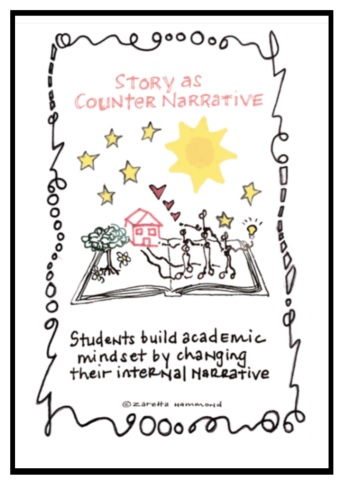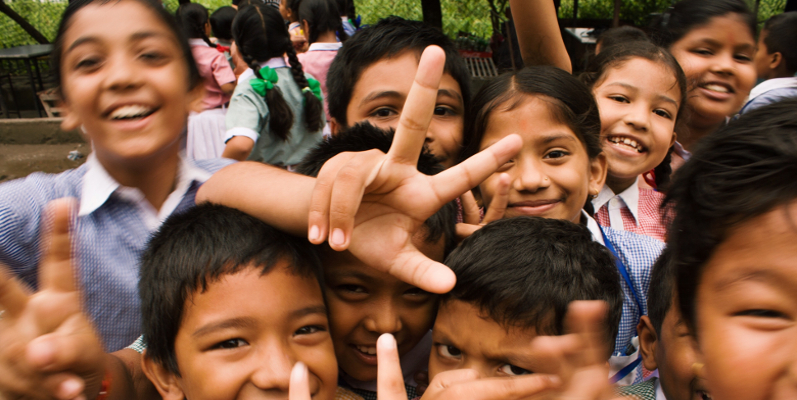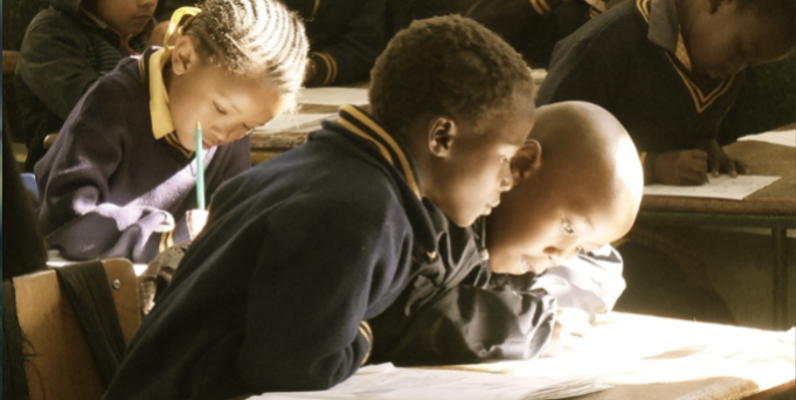I am incredibly honored that Zaretta Hammond is guest blogging for today’s That Thing You Do! segment. Zaretta is an educator and the esteemed author of Culturally Responsive Teaching and The Brain: Promoting Authentic Engagement and Rigor Among Culturally and Linguistically Diverse Students. You can follow her at www.ready4rigor.com and on Twitter @Ready4rigor
Counter-Narratives Support Student Identity and Agency
Relationships are the on-ramp to learning. Trust is the secret weapon of the culturally responsive teacher. Because when students trust that we have their best interests at heart, they give us permission to push them to higher levels of achievement.
In order to help them see themselves as strong readers and writers or as confident learners, they must have a strong academic mindset. Unfortunately, too many diverse students who are dependent learners have internalized some of the negative labels put on them – unmotivated, not intellectually capable to name a few. They believe they can’t learn at high levels or can’t take on rigorous content.

When students accept this negative view of themselves, they are creating an internalized “story” to explain to themselves why they struggle. As a result, they develop a fixed mindset.
What they need is a new story to tell themselves, a new internal dialogue that re-affirms their capacity for learning. This is the foundation of a counter-narrative. A counter- narrative isn’t hyped-up platitudes. It’s not about positive thinking. It is about cultivating each student’s identity as a learner by having him shift his internal dialogue.
Here are two things we can do to help students cultivate a positive counter narrative.
Practice “noticing and naming” to help students craft a new narrative.
Naming and noticing is about recognizing student capacities that the student often ignores and drawing students’ attention to them. This type of pattern recognition is powerful. Point out how they have grown as learners or when they are using their natural gifts. Maybe you notice how a student solved a problem in a unique way by using knowledge from previous lessons. Once a student starts noticing certain things about his capacity as a learner, it is hard not to notice it again. We call this perceptual bias. We tend to see a thing more often once it is pointed out to us where we were once blind to it.
Noticing and naming is a critical practice for culturally responsive teachers. Doing it regularly activates the brain’s reticular activating system or RAS. The RAS is the brain’s 24-hour search engine that looks for events and experiences that confirm what is being named and noticed. When it finds them, it literally rewires the brain’s neural pathways to make permanent circuits that “hold” our story and use it to guide our actions and behaviors in everyday life.
There is another aspect of noticing and naming we don’t want to ignore. Students will often repeat negative statements about their own capabilities or about the capabilities of others in their particular racial, gender, or language group. We want to name and notice when they are engaged in negative self-talk. Without shaming or blaming, we must interrupt that behavior or point out how those statements aren’t true by re-framing or refuting those statements.
Use questions and prompts like these to help build a strong counter-narrative:
- Remember during the first month when we had to really work at [fill in the blank]. Now you can do that automatically.
- Tell me what went well for you during the lesson.
- What interesting thing did you do as a writer [reader, thinker, or mathematician] today?
Use literature to help deepen the counter-narrative
In addition to what students say to themselves as part of noticing and naming, we can use texts to play a key role in strengthening a counter-narrative. Remember that the books students read (along with the movies they watch and music they listen to) can be either “disabling” by reinforcing negative self-image or they can promote a counter narrative that is “enabling” in two important ways:
- Enabling texts promote a healthy psyche for students that affirms their worth and capacity
- Enabling texts serve as a road map for being, doing, thinking, and acting as they navigate racial, language, and gender politics in the larger society in ways that counter labels of “unmotivated, less intelligent, and less capable.”
You can use these characteristics of enabling texts as a guide when selecting companion texts to the books or textbooks mandated in the curriculum.
Just keep in mind, the goal is to have students formulate and own their individual and collective counter-narratives. That means you have to give them regular opportunities to speak these counter-narratives aloud to themselves and to others. For example, have student regularly use the Success Analysis Protocol to look at and say out loud what progress or success they’re proud of at the end of a lesson or unit.
–Zaretta Hammond
If you have not yet read Zaretta’s book, I highly recommend it–one of the best books I’ve read in 30+ years in education.












Always read to them and encourage them to read aloud with you as you ,that will help build them up
It is true that trust is key on building a good repor with children.
excellent material on self reflection
I appreciated the recap of the five takeways and the specific stories given in the podcast.
It was very interesting training for me because I learned how to feel confortoble in the classroom and help students feel contortoble too by giving them support.they are coming from different countries gender and languages.
I like the suggestion of having students say out loud what progress or success they’re proud of at the end of a lesson or unit.
I am a total believer that literature can help students with their identity especially when the appropriate books are chosen. There are so many books on different cultures, race, and diversity, that can benefit our diverse classroom. It is very important for students to be able to identify themselves within their peers. They need to find and feel their self worth.
It will be a wise thing to have and read books from different culture to the children.also, display posters, artfact, food from divers culture in our classroom for the children to explore and investigate.
story time is the best time to engage with students
I like the idea of reminding a child/ren of how far they have come from the beginning of the year.
We should always encourage children to speak about their progress and/or success.
I believe that movies and literature can foster positive identities in children
All live matter, across the world, many of us are motivated to learn more about racism, and talk to ours students and children. Education is a powerful tool for creating change. So , its important teachers don’t shy away from difficult conversation in classroom , even if they may feel daunting.
Absolutely true , once a student starts noticing certain things about his capacity as a learner it is hard not to notice it again.
I work every year to create a safe haven for my students. Their reflections are written across the room on a myriad of topics. Flags of our nations are proudly posted in the Art Area, with student reflections.
Being a confident learner definitely will help students strive to reach all of their abilities.
Changing the narrative is important , just the other day a 4 year old said she wanted to learn so she would not be homeless. I told the child some people were homeless even though they were learners. Homelessness can happen to anyone it does not discriminate just like covid-19,. Though some may be more susceptible in either case , what are we willing to do about it ?
Reflection every day helps teach children to think back about their days
I love to read to my children because its create a new and unique critical thinking, inclusive, and cohesive community.
It is ok to be different once each person feel the respect of others.
I appreciate the five takeaway
Choosing appropriate literature helps children relate to their identity. Also, I liked the idea how children talk about their progress.
Children can take so much information about their identities from all of different books. Books can be written in so many different authors from different languages. We just need to invite a person who can read in front of children. The children can absorb just like sponge so they become apprehend all of different cultures and languages as well.
Yes, literature helps students to create their counter narrative to deflect negative comments and perceptions of their social groups.
Literature is a good thing for children especially gaining knowledge
Thanks for this beautiful material and reflection.
Promoting healthy conversations and understanding all culturally diverse populations is essential to helping our students break stigmas and create a more inclusive environment!
Encourage students to talk about themselves share about their culture to the class and really offer positive praise. This helps build confidence in themselves and about their background
Allowing for each student to share about their family, culture, language, or anything at home.
I think books are very important for children to see their culture and their traditions reflected in them. As educators, we must choose books that show the diversity of our children. As the blog said, texts reflect the awareness of the real world that validates their experiences. I like the idea of thinking as books as roadmaps that show children how the character navigates through racial, language, and gender politics in the larger society.
Respect everyone’s culture, share yours